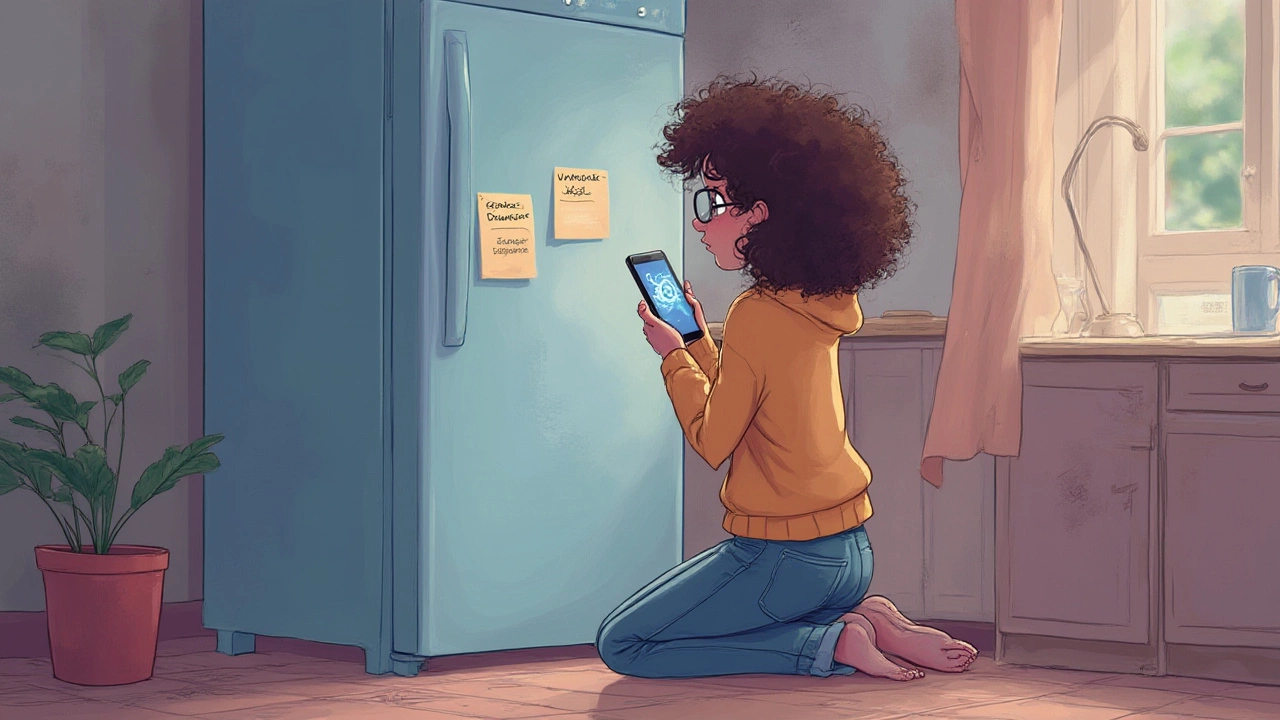Nothing ruins your day quite like reaching into your fridge and realizing your milk is warm. Suddenly you start second guessing: was it that midnight snack run, or is the fridge actually failing? Before you panic-buy a replacement or call an expensive repair tech, you can get to the root of many refrigerator problems at home. Even if you’re not the handiest person, some smart observations, a few solid facts, and a bit of patience go a long way.
Spotting Refrigerator Warning Signs Early
Most refrigerators give you a heads up that something’s off before completely shutting down. Think about any odd humming, buzzing, or clicking noises you’ve noticed. Maybe there’s water pooling by the feet, or leafy greens are freezing in the crisper drawer. Even if your food looks normal, strong odors can be a sign the temperature isn’t holding steady. A surprising fact: a typical household throws away 35 kilograms of spoiled food each year, mainly because of unnoticed fridge issues sneaking up for weeks.
Sometimes doors don’t seal right, the light doesn’t turn on, or there are new rattles after a DIY move. Take these signs seriously. Problems like frost buildup mean airflow is blocked, while sticky handles or gunk on the door gasket can mess with temperature, costing you money. Even a warm can of soda is worth checking out. Don’t ignore puddles inside or beneath the fridge, even if you clean them up quickly—they often point to blocked defrost drains or leaky water lines. Weird smells? Those can mean bacteria are building up because it’s not cold enough. Look at temperature: it should hold steady at about 3°C to 5°C for the fridge and -18°C for the freezer. Anything warmer leads to faster food spoilage—and that’s your first clue trouble’s brewing.
Checking the Basics: Power, Settings, and Placement
Sudden fridge failure isn’t always a disaster. Start with the basics—sometimes the problem is embarrassingly simple. See if it’s properly plugged in (yes, really). Outlets nearby might be controlled by a wall switch, or you may have tripped a breaker without realizing. If the light doesn’t come on or the appliance is silent, test another device in the outlet to check.
Double check the temperature settings. Kids, houseguests, or a cleaning spree can accidentally twist the dials. Some modern fridges have digital displays or lockable panels, but old-school rotary dials are easy to nudge. Aim for the middle setting, then wait a day to measure the temperature with a fridge thermometer. Keep in mind: refrigerators actually work harder in the summer or when crowded with food. Leave space for air to flow inside, especially at the back and top. A fridge jammed in a corner, pressed against the wall, or sitting in direct sunlight will strain itself, run hotter, and fail sooner. If you just moved your fridge after a deep clean or defrosting, let it settle upright for a few hours before plugging back in. This lets oil in the compressor settle, preventing damage when it starts up.
Decoding Refrigerator Sounds and Temperatures
Have you ever noticed your fridge making a weird clicking noise, or running for hours at a time without stopping? The typical fridge cycles on and off a few times each hour, but if you constantly hear the compressor running—or it’s totally silent—that’s a red flag. A steady, regular hum is normal; clicking, pinging, or loud pops? Not so much. Clicking could come from a failing start relay, a cheap part you can replace yourself for about $20 if you’re handy.
Be aware that older refrigerators sound different than newer energy-efficient models. Some are just much quieter, with fans and compressors at the back. But silence can also mean the thermostat, timer, or compressor has failed. Feeling around the outside helps too. If the sides or back are scalding hot, the condenser coils (usually behind a panel at the bottom or rear) might be filthy. Dusty coils make the fridge overheat. Unplug it, gently vacuum the coils, and watch for improvement—a five-minute job that can save years on your appliance’s life.
Try placing a glass of water in both the fridge and freezer. After a few hours, check if the freezer’s water is frozen solid and if the fridge’s water feels cold—not icy, not lukewarm. Use a digital thermometer for a more scientific read. If food at the back freezes and food at the front is too warm, your evaporator fan or vents may be blocked, or the defrost heater could be malfunctioning. These clues help you zero in on the weak link.

Pinpointing Common Refrigerator Problems
All right, so you’ve run through the basics and the weirdness continues. Time to get specific. Below are some classic refrigerator troubles and what usually causes each:
- Fridge Not Cooling: If the freezer feels fine but the fridge is warm, airflow between them may be blocked. Frosted coils, failed evaporator fan, or stuck damper doors are typical culprits. Sometimes, cold air can’t circulate because overloaded shelves are pressed against the vents.
- Excessive Frost or Ice Buildup: Not normal, even in the freezer. This usually means bad door gaskets, doors left ajar, or a broken defrost system. Look for a lot of ice on the freezer wall or around the door frame.
- Noisy Refrigerator: Aside from normal humming, grinding or knocking means something’s up with the compressor, condenser fan, or evaporator fan. A failed fan is a cheap fix if you’re up for it, but compressor trouble usually needs a pro.
- Water Leaks: Water pooling under your fridge is often from a clogged defrost drain, loose water line, or blocked drain pan. This rarely requires fancy tools. Use a turkey baster or flexible brush to clear drains. For leaks from the ice maker or water dispenser, check tubing for cracks or kinks.
- Lights On, Fridge Off: If the lights work but nothing’s running, it’s likely a faulty start relay, defrost timer, or thermostat. These parts aren’t too expensive and can be replaced if you’re comfortable doing light repairs.
Here’s a quick pro tip: unplug your fridge for five minutes, then plug it back in. If it restarts and works for a few hours before failing again, it could be the defrost timer or control board. A handy chart on the inside of many fridge doors shows the normal temperature range; check for frost patterns, which point to blocked vents or a failed defrost cycle. And if your model produces unusual error codes or flashing lights, look up the exact code online; manufacturers post service manuals for most units. Even older models have publicly available troubleshooting guides online, which you can access with the serial and model numbers usually found just inside the fridge compartment.
Quick fun fact: Samsung, GE, and Whirlpool report that clogged coils and defrost issues make up nearly 60% of all fridge repair calls, so it’s well worth learning how to spot and clean those trouble spots yourself.
When to Call for Professional Refrigerator Repair
Some fridge repairs are simple enough for beginners—like replacing a water filter, cleaning a drain pan, or swapping a door gasket. But there’s a line. If your fridge compressor is toast, if refrigerant lines are leaking, or if you hear hissing or smell something burning, it’s time to get pro help. Even pretty confident DIY fans avoid working with sealed refrigerant systems due to health and legal issues. In fact, US Environmental Protection Agency rules ban unlicensed refrigerant handling, so don’t take risks here.
Still, you can save a lot of time and money just by narrowing down the issue before calling in help. Techs charge for travel and diagnostic time, so if you can say, “The freezer stays cold, but the fridge isn’t cooling and the fan isn’t blowing air,” you’ll get a faster fix. Take photos of error codes, strange ice or water patterns, and keep a record of any blinking lights or reset attempts. If your fridge is under five years old, check if it’s still on warranty. Many manufacturers cover sealed system parts for up to ten years. Calling the support line with serial and model numbers ready shaves hours off the process.
So what’s the average fridge lifespan? About 13 years, but some soldier on for more than 20 if you treat them right. If the repairs you face cost more than half the price of a new fridge, or if you’re seeing repeated issues, it’s worth weighing an upgrade. Expect to pay anywhere from $100 to $400 for mid-level fixes, while sealed system work can run much higher.
Always prioritize safety. If a fridge is sparking, smells like burned wires, or the casing is hot to the touch, unplug it and keep clear until a pro arrives. Fridges use a lot of electricity—rated among the highest for any household appliance—so never work on a plugged-in unit, and always check twice before poking around with tools.
Pro Tips to Prevent Future Refrigerator Trouble
Avoiding future headaches is easier than you think. Clean those condenser coils every six months using a soft brush, vacuum, or coil cleaning tool from the hardware store. Make sure your fridge is level—unlevel units make the doors not seal, which messes with temps and burns out components faster. Wipe down door gaskets every couple of weeks to keep them flexible. A little petroleum jelly on the gasket keeps it supple and provides a better air seal.
Check the door for leaks with the dollar bill test: shut the bill in the door and pull. If it slides out easily, you need to replace the gasket. Don’t cram the fridge so full that air can’t move, especially up and down. And if you have pets, check the coils even more often: pet hair gums up airflow, which tanks efficiency.
If your fridge has a water or ice dispenser, swap out the water filter every six months. Skip the cheapest knockoff filters, since they often clog. Modern fridges log filter change dates—check your manual for the best practice. Also, resist the urge to keep the temperature super-low. You’ll just burn more electricity and risk freezing fresh food.
A foolish but common mistake: storing hot leftovers. Let them cool on the counter before putting them in. Hot food makes the compressor work overtime, raising the temperature for everything else inside. Same with opening the door for long stretches—work quickly and keep the cool air in.
Even if you can’t fix every fridge problem yourself, knowing these basics puts you miles ahead when things go wrong. Whether you’re facing a mystery puddle, weird noises, or just not-so-cold milk, you’re armed with the know-how to spot the signs, check the details, and decide if you can save some cash before bringing in the cavalry.


